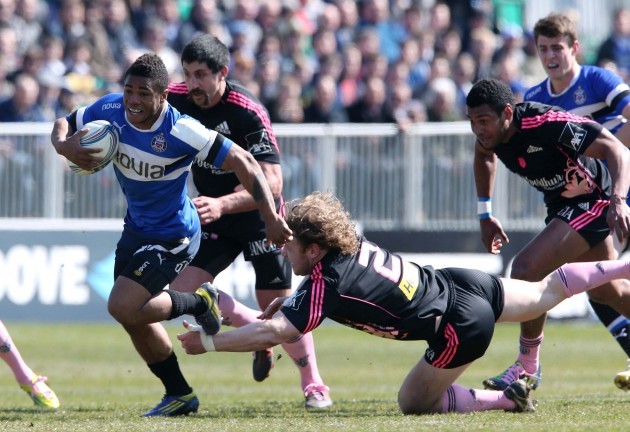WHEN DID WE become obsessed with spinning our passes?
The proliferation of the spin pass in rugby has taken over to such an extent that we rarely see anything else over medium-range distances. When we talk about good passers, we invariably look at the men and women who can send long, spinning passes to outside backs, but good passing is about far more than that.
There is certainly a vital role for the spin pass in rugby; when looking for length, it proves invaluable, while spinning passes can add real power and speed too [and are vital for scrum-half delivery]. But on so many other occasions, a spin pass is not the best option.
Mark Reason has written before about how rugby union could learn so much from rugby league passing, something worth reiterating. While the latter code has a reputation for being simply about physical power, players at the top level of the sport possess wonderfully balanced passing skills. They can fire long spin passes and pop short, weighted passes to runners closer to them.
The best passers in rugby recognise that they need to use a range of passes to best unlock a defence, and to give their teammates the greatest chance of doing damage when they receive the ball. Often we see a spin pass used over short distances, when a more standard pass would work better and be easier to catch.
One of the most interesting attacking midfields in the Northern Hemisphere at the moment is that at Bath in the Aviva Premiership. The little club from the southwest of England are flying high in third in the league and much of their attacking prowess is down to the influence of out-half George Ford and inside centre Kyle Eastmond.
Both are notably strong passers and both have an understanding of and appreciation for space. Ford is still only 20, but already he looks ready for international rugby, while Eastmond won his first England caps last summer in Argentina.
Ford is the son of Mike, one-time Ireland defence coach and now in charge at Bath. The Ford family is deeply rooted in rugby league, with George having spent time in the Wigan Warriors academy as a youngster, while his father played the sport to a high level.
Eastmond [24] signed for Bath in 2011, making the code switch from league, where he had won four caps for England. Both young players show all the hallmarks of a rugby league education in their short and medium-range passing style, end-over-end or simply flat without a spin.
While league is very different to union in so many ways, there are certainly aspects of the game that can help union players improve. The rush defence favoured by so many top-level teams in union has its roots in rugby league; there is more we can learn.
Passing is certainly somewhere we can pick up pointers, as Ford and Eastmond are demonstrating. The examples below are all taken from Bath’s Amlin Challenge Cup match against a second-string Bordeaux Bègles last month. It was a facile outing for Bath, but it did at least provide lots of opportunities for Ford and Eastmond to pass the ball.
The Premiership side scored with their very first attack of the game, against some shambolic defence from the Top 14 outfit. What we’re more interested is the passing by Bath to create the initial line-break; no spin, just firm passes that are easy to catch.
The end-over-end style of passing that is common to rugby league is usually highly apparent in Bath’s play too. Obviously, head coach Mike Ford looks to use many elements of his league background in his union coaching, both defensively and in attack. An end-over-end pass can be so much easier to catch than one spinning side-over-side.
We see lots of screen passing from Ford’s men, where the passer pulls the ball deep behind a decoy runner to a new wave of attack. In the video below, you’ll see some fine examples of that exact set-up, which is rife is rugby league. Underlining everything Bath do is the passing of Ford and Eastmond.
Both players have strong ‘rugby brains’; that is, they make good decisions based on the defenders’ positioning, the available space and their teammates’ running lines. However, those skills are pointless if the wrong pass is utilised. Both Ford and Eastmond are sympathetic in their passing; when a teammate is close enough, they don’t spin the ball.
Quite often, union players will spin passes that really don’t need to be spun; there are times when a simple, traditional pass is the best option, or an end-over end effort will be easier to catch. You don’t want your best attacking runners to actually have to stress over catching the ball before they actually get a chance to do their damage.
Sometimes, simple and plain is best; sometimes a pass doesn’t need much power or spin. In the clip below you can see that winger Semesa Rokoduguni actually catches Eastmond’s pass in one hand [we're not advocating that, but the point is obvious.]
Ford and Eastmond have many other strengths to their game – the out-half kicks very well and possesses a great tactical understanding, while the centre has superb footwork – but it is their sympathetic, weighted and often not-spun passing that allows their team to prosper in attack.
As an aside, England have been attempting to use Billy Twelvetrees in a similar play-making, ball-playing second-five-eighth role to Eastmond at Bath, but his passing has let him down oftentimes. The sight of the Gloucester man spinning powerful passes to teammates close to him has been frustrating, particularly as Eastmond has shown that he can play the role effectively.


